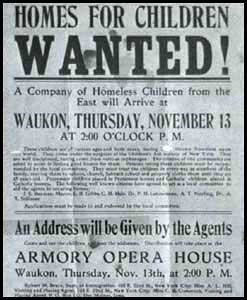On this Labor Day, we honor the labor and precarious existence of those who were forced onto the Orphan Trains. Here is selection of passages (referenced and in some cases linked for further study) that tell about the founding and the passengers aboard the Orphan Trains.
An Introduction
“…Transferring children has been a process since American colonial times, but not legitimized until the creation of adoption statutes. In the early decades of American society, there was no formal procedure in place for recording births and name changes; any arrangement would be informal and most likely economically motivated. With farm industrialization in America, came the need for cheap labor. Families that could not afford to care for their children conducted an informal transfer, by giving their child directly to another family, or leaving their child at a charitable institution. Unfortunately, this informal transfer fueled the orphan train’s from 1854-1929. American society expected that children in informal placement received benefits of care, support, and education; unfortunately, this was not the case for all. Some children were lucky enough to have a formal adoption and received a share in the land and others were unlucky and adopted for free labor until adulthood.” (Research Paper Katharyn Sanford MSW Intern at Adoption STAR).

How the Trains Began their Run
“The children ranged in age from about six to 18 and shared a common grim existence. Homeless or neglected, they lived in New York City’s streets and slums with little or no hope of a successful future. Their numbers were large – an estimated 30,000 children were homeless in New York City in the 1850s. Charles Loring Brace, the founder of The Children’s Aid Society, believed that there was a way to change the futures of these children. By removing youngsters from the poverty and debauchery of the city streets and placing them in morally upright farm families, he thought they would have a chance of escaping a lifetime of suffering.
He proposed that these children be sent by train to live and work on farms out west. They would be placed in homes for free but they would serve as an extra pair of hands to help with chores around the farm.” (http://www.childrensaidsociety.org/about/history/orphan-trains)

On the Train
“…Brace knew that American pioneers could use help settling the American West, so he arranged to send the orphaned children to pioneer families. ‘In every American community, especially in a Western one, there are many spare places at the table of life,” Brace wrote. “They have enough for themselves and the stranger too.’ … Conditions on the early trains were poor, little better than cattle cars. In later years, conditions improved.
The children were encouraged to break completely with their past. The children would typically arrive in a town where local community leaders had assembled interested townspeople. The children would usually be put up on a ‘stage like’ podium for viewing and inspection. The townspeople would inspect the children, perhaps feeling muscles and checking teeth, and after a brief interviews take the chosen ones home. Children might sing or dance to attract interest. Sadly, many siblings were separated during this process because the parents only wanted to take one child. Some children became indentured servants to their host families, while most were adopted, formally or informally, as family members.” (http://en.wikipedia.org/wiki/Orphan_Train)

…in Closing
“As The Orphan Trains so poignantly reveals, even those for whom the journey ultimately was a triumph found the transition from one life to another almost always painful and confusing. ‘I would give a hundred worlds like this,’ wrote one child from her new comfortable home, ‘if you could see my mother,’ Brace himself grappled with the dilemma: ‘When a child of the streets stands before you in rags, with a tear-stained face, you cannot easily forget him. And yet, you are perplexed what to do. The human soul is difficult to interfere with. You hesitate how far you should go.'” (http://www.pbs.org/wgbh/amex/orphan/)
Read More Adoption History: African American Adoption in the Early 20th Century, Issues and Perspective in Adoption Then and Now, Part 1, Issues and Perspective in Adoption Then and Now, Part 2, Issues and Perspective in Adoption Then and Now, Part 3, “…walking together as brothers and sisters”.
© Adoption STAR blog, 2013. Unauthorized use and/or duplication of this material without express and written permission from this blog’s author and/or owner is strictly prohibited. Excerpts and links may be used, provided that full and clear credit is given to the Adoption STAR Blog with appropriate and specific direction to the original content.

